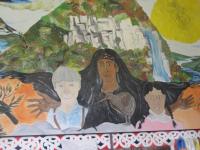Stories Relating to Our School Pepeha
The History of Owairaka Mountain
A long time ago there lived a young, beautiful woman from Ngati Awa. She had a father as a chief. Her name was Wairaka. When she was a teenager, her brother got banished, so he came to Tama - Ki - ma - kaurau and lived on the maunga/mountain.
After a couple of years, Wairaka came to visit her brother but when she got there, her brother had already moved on, so she renamed the mountain Owairaka.
And this is the story of how Owairaka got its name ...
At the end Wairaka lost the battle. She lost her land and everything except the school ground. Back then if you lost a battle you lost everything you had, so this land is called Owairaka which means belonging to Wairaka.
The Story of Our River
Long, long ago when history had just begun for Wairaka, her tribe travelled all the way from Whakatane to Tamakimakaurau. As they were walking, Wairaka became very thirsty. She asked her father if she could have a drink. Her father ignored her, and the same thing happened over and over again. It went on and on until finally she could no longer stand it. She was so angry that she erupted into a tantrum. She stomped her foot on the ground so hard that a spring came up from the ground. She took a long drink from the spring which seemed like hours or maybe a whole day. Nowadays when you go to Unitec you can see the river. It is called, “Te Puna Wai-Inu-Roa o Wairaka,” meaning the “Long Drink of Wairaka,” and that’s how Te Puna wai inu roa o Wairaka came to be.
Our Whare Nga Ringa Awhina
Ngā Ringa Awhina is the room our whanau uses for Te Reo lessons. Ngā ringa means, "the helping hands." Bi-lingual classes at Owairaka school began in 1989. There is a special mural in the classroom that was painted by the children from the whanau. It incorporates Owairaka mountain, the story of Owairaka and a fantail which is a kaitiaki or guardian that looks after the well-being of the children at our school. It also represents all the different nationalities of our school, at that time which was mostly Maori and European, this is very different to the many cultures that opt into the weekly Te Reo and kapa haka sessions.
Before entering Ngā Ringa Awhina, your shoes must be taken off. We do this in respect of the whare - as if it was a meeting house or as if we were going into someone's home. We have displayed our pepeha outside the whare and hope to display another near the road indicating our Maori culture within such a culturally diverse school environment .


